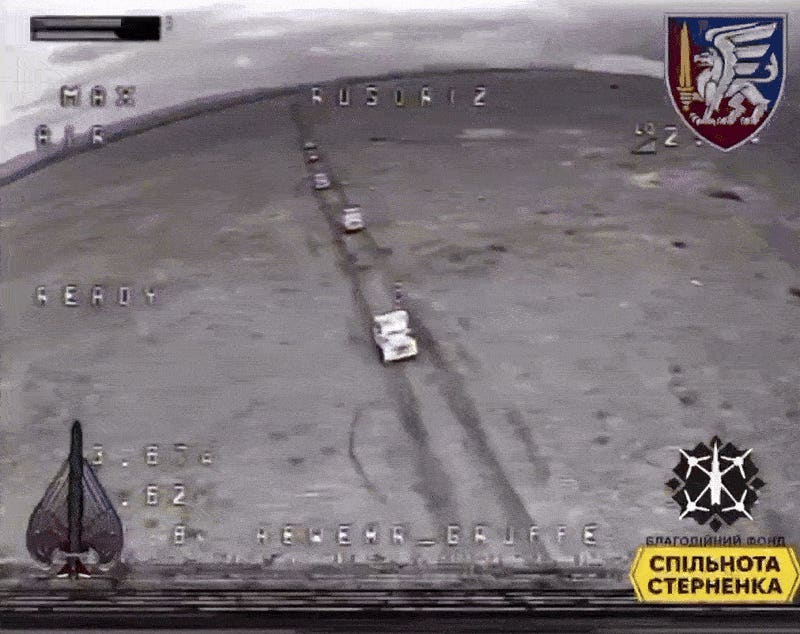A drone strikes a Russian GAZ-69.
Abwehr Gruppe capture
A few weeks after first appearing in significant numbers along the front line in Ukraine, Russian GAZ-69 trucks—museum pieces from the 1950s—seem to have participated in their first direct assault on Ukrainian positions.
“We are an inch away from the GAZ-69 sturm,” open-source intelligence analyst Moklasen predicted on April 1, using slang for “attack.” They were right.
The Thursday assault outside Bilohorivka, at the juncture of Luhansk and Donetsk Oblasts in eastern Ukraine, ended badly for at least one of the 3,500-pound, four-wheel-drive GAZ-69s, which rolled off the assembly line at the Molotov plant in Moscow some time between 1952 and 1972.
The trucks are totally unarmored except for the anti-drone cages some Russian troops weld onto them.
The GAZ-69 was struck by a first-person-view drone from the Ukrainian Abwehr Gruppe drone team, part of the 81st Air Mobile Brigade. The rest of the civilian-style vehicles in the platoon-sized column—potentially including additional GAZ-69s—also came under attack.
“No one arrived, no one reached” Ukrainian positions, the Abwehr Gruppe reported.
An up-armored GAZ-69.
Via Special Kherson Cat
70-year-old assault trucks
The best-protected Russian assault groups struggle to cross the mine-seeded, artillery-pocked, drone-patrolled front line of Russia’s 38-month-long wider war on Ukraine. Lightly protected assault groups in civilian trucks, all-terrain vehicles and motorcycles tend to fare even worse.
But more and more Russian regiments are riding in civilian vehicles as Russia’s losses of purpose-made combat vehicles exceed 20,000 and factories struggle to build new vehicles fast enough.
And that helps to explain why the numerically superior Russian force in eastern Ukraine, which may number more than half a million, has been struggling to gain ground.
“Despite holding the advantage along much of the frontline, Russia’s winter campaign yielded limited results—indicating Ukraine’s situation is not dire,” concluded Tatarigami, the founder of Frontelligence Insight, a Ukrainian analysis group.
That doesn’t mean the better-equipped—or luckier—Russian assault groups won’t advance a short distance here or there. Indeed, Russian regiments gained some ground south of Bilohorivka in recent days, according to the Ukrainian Center for Defense Strategies.
It does mean that, overall, the Russian army in Ukraine is increasingly ill-equipped for a major offensive—and likewise ill-equipped to exploit any localized breakthrough resulting from a successful assault. What was once one of the world’s great mechanized armies is de-mechanizing at a rapid pace.
